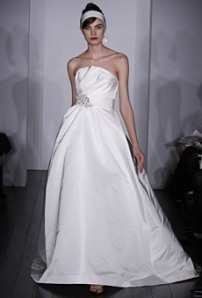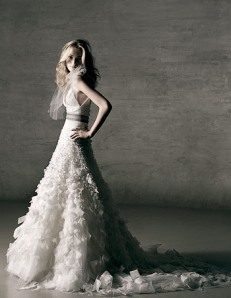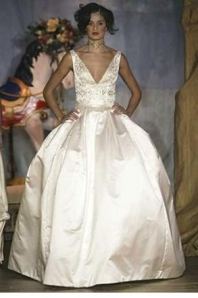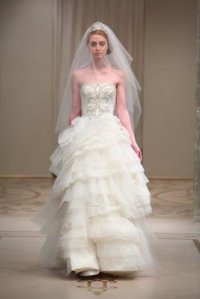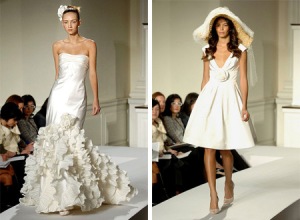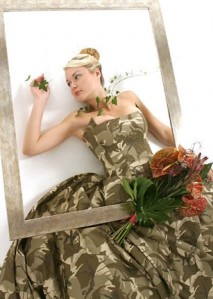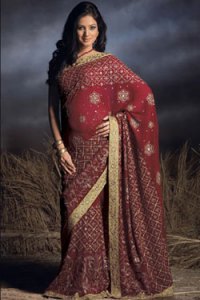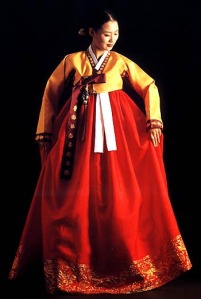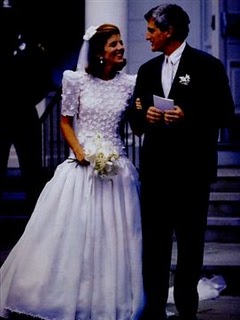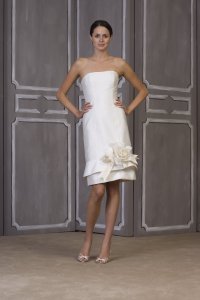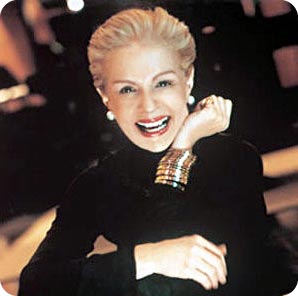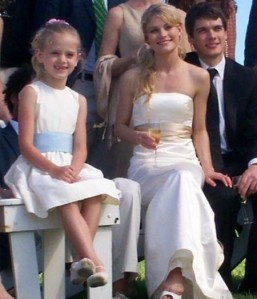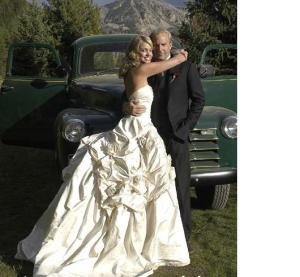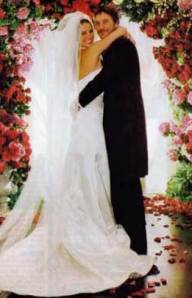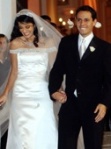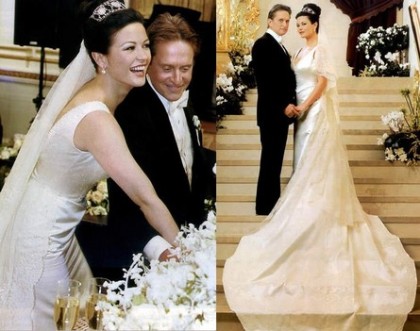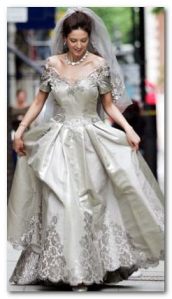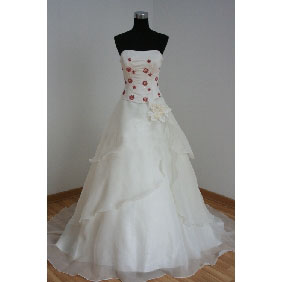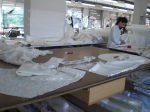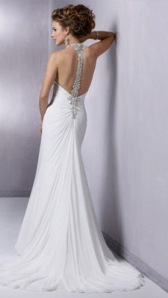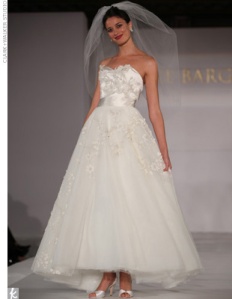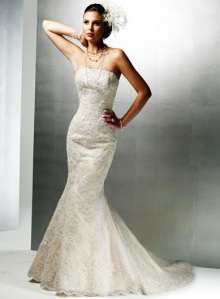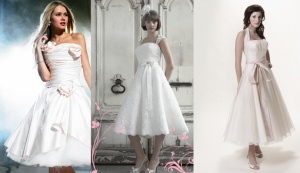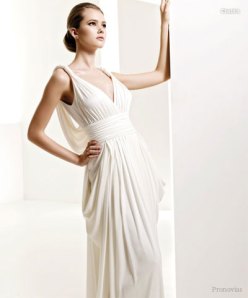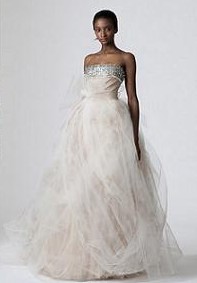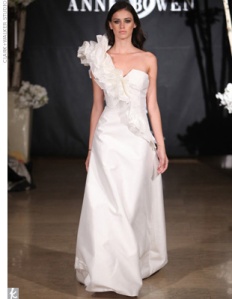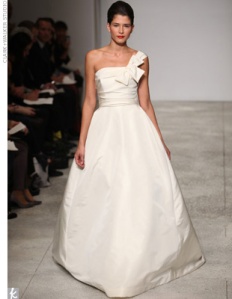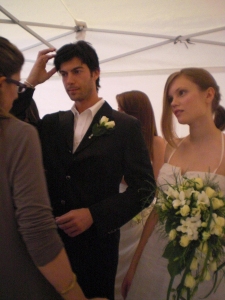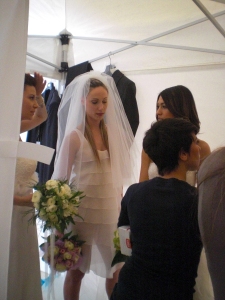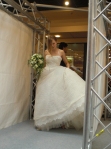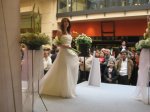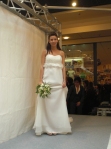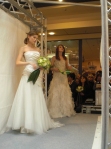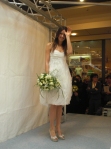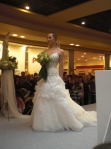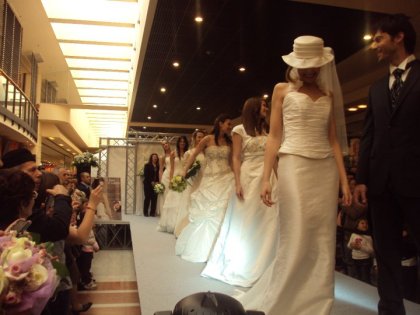Filed under: Big Names
Every season, the bridal designers debut their latest collections in New York. There are numerous designers, but from those, there are a select few whose collections are always eagerly anticipated, much sought after by brides, and often imitated by their competitors. These are profiles of the top seven most influential bridal gown designers.
Priscilla of Boston: The First Famous Bridal Gown Designer
The Priscilla of Boston bridal gown collection is by far the oldest house among the most influential wedding designers. Founded in 1945 by Priscilla Kidder as “The Bride’s Shop” in Newbury Street (Boston), the company that was to become Priscilla of Boston gained a reputation for both the quality of its service and its wedding gowns. The gowns were made by hand in a factory in Charlestown, Massachusetts in the greater Boston area. Many of the firm’s wedding dresses are still made in the original factory, and it is possible to tour the facilities and watch a gown being assembled or the beaders handbeading a piece of lace with Swarovski crystals and pearls.
By the 1950s, Priscilla of Boston gowns were the gold standard for brides with discerning taste, and they were carried in the top name department stores. The gowns were famous for their exquisite silks, hand beadwork, and French laces. Alençon, Chantilly, and Lyon laces were some of the preferred trimmings for Priscilla Kidder’s bridal gowns. In 1956, Kidder was granted the honor of designing the bridesmaid dresses for the wedding of Grace Kelly, and other high profile weddings would soon follow. In a span of six years, three Presidential daughters walked down the aisle in Priscilla of Boston gowns: Luci Johnson (1965), Julie Nixon (1968), and Tricia Nixon (1971).
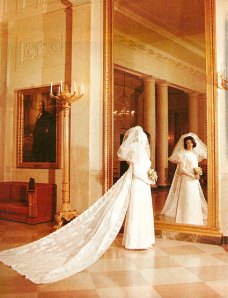
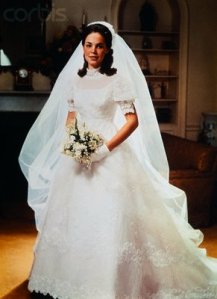
 In one way, Priscilla of Boston was to influence every bridal designer who was to follow in her footsteps: she was the first to promote her name and brand as a status symbol. There could be no Vera Wang had there not first been a Priscilla Kidder. The founder retired at the age of 75 in 1993, but the company continued to create designs in the same Charlestown factory. The 2000s brought many changes to the venerable old firm, including the sale of Priscilla of Boston to the May Company in 2002, the death of Priscilla Kidder in 2004, the 2005 acquisition of bridal designer Melissa Sweet, and expansion into sister lines Platinum by Priscilla, Vineyard, and Jewel. The goal of the Priscilla of Boston collection of brands is to meet the needs of every type of bride, from the traditional, to the ultra luxurious, the modern, and the eclectic. There can be no doubt about the influential nature of this updated bridal powerhouse.
In one way, Priscilla of Boston was to influence every bridal designer who was to follow in her footsteps: she was the first to promote her name and brand as a status symbol. There could be no Vera Wang had there not first been a Priscilla Kidder. The founder retired at the age of 75 in 1993, but the company continued to create designs in the same Charlestown factory. The 2000s brought many changes to the venerable old firm, including the sale of Priscilla of Boston to the May Company in 2002, the death of Priscilla Kidder in 2004, the 2005 acquisition of bridal designer Melissa Sweet, and expansion into sister lines Platinum by Priscilla, Vineyard, and Jewel. The goal of the Priscilla of Boston collection of brands is to meet the needs of every type of bride, from the traditional, to the ultra luxurious, the modern, and the eclectic. There can be no doubt about the influential nature of this updated bridal powerhouse.
Vera Wang Revolutionizes Wedding Gowns
There is no woman who has had a greater impact on modern American weddings than Vera Wang. Her wedding gowns are among the most trendsetting in the bridal industry.
The story of how Vera Wang got her start as a bridal gown designer is legendary. When she was planning her 1989 wedding, she was dismayed to find nothing but overblown “princess style” bridal gowns. Wang came to realize that there was a serious disconnect between bridal and high fashion, and set out to change that. And she did! After Vera Wang opened her first bridal salon in New York in 1990, the bridal gown industry was transformed from one that was stuck in the past to one that is relevant and inspirational to both the modern bride and the larger fashion industry as a whole.
Plenty of brides have had a difficult time finding the wedding gown of their dreams, but very few are able to turn a frustrating experience into a global enterprise. Vera Wang was uniquely positioned to achieve this level of success. Born on June 27, 1949 in New York to wealthy Chinese parents, Wang attended elite schools (The Chapin School, Sarah Lawrence College, and the Sorbonne in Paris). Her early passion was figure skating, but when she was not chosen for the U.S. Olympic team, she decided to pursue one of her other lifelong passions: fashion.
Wang spent sixteen years as a fashion editor at Vogue before departing to work at Ralph Lauren in 1985. By the time of Wang’s wedding in 1989, she had all the tools in place to launch the bridal line that would become synonymous with luxury, modern elegance, and high fashion. Vera had years of training in the fashion industry, connections within both fashion and upper crust society, and a keen eye for style. From the bridal collection’s 1990 debut, the Vera Wang label quickly became the go-to wedding gown brand for the rich and famous, as well as for the regular bride who values top design. Celebrity clients include Jennifer Lopez, Jessica Simpson, Mariah Carey, Karenna Gore, Victoria Beckham, Sharon Stone, Kate Hudson, and many more.
Vera Wang branched out from the bridal industry into designing other special occasion gowns, eventually evolving into a full lifestyle brand with products ranging from ready wear clothing, housewares, fragrance, wedding stationery, and fine jewelry. Wang’s signature style is modern, trendsetting, sophisticated, and whimsical. Her philosophy is that brides fall into five general categories: traditionalist, modernist, individualist, romanticist, and minimalist; Wang’s intention is to design the perfect bridal gown for each of these types of women, and if her international popularity is any guideline, she has certainly achieved her goal!
The Forever Modern Style of Amsale
Vera Wang is not the only high profile bridal designer who got her start due to the lack of selection when she planned her own wedding. Amsale Aberra, who was born in Ethiopia, had a very similar experience. Amsale grew up in Ethiopia, which she left to attend college in Massachusetts. Her focus at the time was commercial art; Aberra later said that while a child in Ethopia, she did not know that there was such a career as fashion designer. It was while in college that Amsale became interested in designing clothing; it all began when she started to sew her own clothing to save money. What was born of necessity turned into a passion, and Amsale moved to New York to attend the famous Fashion Institute of Technology.
When Amsale began shopping for a gown for her 1985 wedding, like Wang, she was turned off by the lack of sophistication in the gowns on the market. Shortly after her wedding, the newlywed decided to take matters into her own hands and remedy the situation. Amsale rightly believed that there were other brides out there who desired the same understated elegance that she had sought in a bridal gown. Amsale’s bridal business began with an ad in the newspaper for custom made bridal gowns, which she designed and had made by a small team of talented seamstresses. From the beginning, fine fabrics and quality craftsmanship were trademarks of Amsale’s wedding gowns, and the company that began in her New York City loft apartment eventually grew to be featured in the country’s most luxurious department stores and bridal salons.
The style of an Amsale gown is described as “Forever Modern”, by which the designer means that she works with traditional wedding dress features, but with an eye to creating modern classics. Amsale’s gowns are updated and sophisticated with clean lines. One of her most famous designs is a simple white silk strapless wedding gown with a blue sash. The style, though simple, was revolutionary, and it became a smash hit that has been imitated by countless bridal gown designers since.
Monique Lhuillier’s Gowns Hit The Red Carpet And The Church Aisle
Thank for the lack of chic wedding gowns in the 1980s and early 1990s, for yet another of the most influential bridal designers launched her collection from the same frustrating circumstances as Vera Wang and Amsale. The cutting edge collection of Monique Lhuillier was founded in 1996, fresh off of her disappointment with the bridal gowns on the market when she planned her wedding. The gowns for which Lhuillier has become world famous came about when the 23 year old decided that there were simply not enough choices for the stylish modern bride.
Born in the Phillipines in 1971, Monique Lhuillier’s prominent family sent her to a Swiss boarding school, followed by an education at Fashion Institute of Design and Merchandising. Following her frustrating experiences during her own wedding, Lhuillier set to create the types of gowns which she wanted for herself. Monique Lhuillier’s gowns are best known for her ability to blend classic bride materials, especially lace, with fashion forward styles. Her iconic looks walk the line between sexy and bridal, which has made them a hit with celebrities (she also now designs red carpet gowns in addition to the bridal collection). Some of the famous brides to wear a Monique Lhuillier gown include Britney Spears and Al Gore’s daughter Sarah. If you are interested in stars’ dresses and Lhuillier click here.
Reem Acra’s Bridal Gowns Are Fit For Royalty
When brides are looking for opulent royal gowns for their weddings, they turn to the intricately embroidered creations of designer Reem Acra. Originally discovered by a fashion editor while a student at the American University in Lebanon, the young Lebanese woman showed her first collection only 10 days later. This happy turn of events led to Acra’s decision to pursue a career in fashion; she studied in Paris and later at F.I.T. in New York. The dress that originally drew the fashion editor’s eye was one that Reem Acra had created out of an piece of ornately embroidered silk organza; this sort of lavish embellishment was to become the hallmark of her bridal gown collection.
Reem Acra’s bridal line was launched in 1997. Her career took off when one of her friends wore a Reem Acra bridal gown for her high profile society wedding. It was not long before brides around the world were flocking to the label for opulent, exquisite wedding dresses. Unlike some of the other top bridal designers whose focus is on modern simplicity, Acra’s gowns are unabashedly embellished. She is known for her remarkable metallic embroidery and intricate beadwork in Swarovski crystals and seed pearls. A Reem Acra wedding gown is formal, glamorous, and sophisticated, with a signature style that invokes royalty. Indeed, royal brides have chosen Acra’s European inspired styles for their wedding days. In addition to wedding gowns, Acra also designs gowns for celebrities to wear at premieres and award shows. Her red carpet-worthy creations have been worn by some of Hollywood’s most beautiful and glamorous women, including Catherine Zeta-Jones, Angelina Jolie, Halle Berry, Beyoncè Knowles and others.
Carolina Herrera Has Been Dressing Brides, Debutantes, And Celebrities For 30 Years
Have a look on my post dedicated to Carolina Herrera.
Oscar de la Renta’s Wedding Gowns Epitomize Luxury
The only man on the list of the most influential wedding gown designers, Oscar De La Renta originally hails from the Dominican Republic. Born in 1932, Oscar de la Renta’s fan base includes many of the same celebrities and wealthy clientele as Carolina Herrera’s label. Like Herrera, the bridal collection is a part of a larger lifestyle collection encompassing formal attire, day wear, and accessories. An art lover, Oscar de la Renta moved to Spain to study painting at the age of 18. It was not long before he changed his focus to fashion, obtaining an apprenticeship with the legendary Spanish couturier Balenciaga (it is an interesting coincidence that Balenciaga was Herrera’s first couture show; perhaps it is no accident that de la Renta and Herrera share some similar design aesthetics). De la Renta’s next step was a move to Paris, where he worked for Lanvin, Elizabeth Arden, and Dior before finally starting his own label in 1965.
Oscar de la Renta’s bridal gowns are defined by their couture craftsmanship, femininity, charm, and attention to detail. He is the epitome of luxury and elegance in bridal fashion. Not unlike Carolina Herrera, Oscar de la Renta wedding gowns are often strapless with classic silhouettes. He makes great use of embroidered organzas and laces, as well as flounces and ruffles with a touch of Latin flair. Former President Bush’s daughter Jenna was one of the best known brides to wear an Oscar de la Renta gown for her wedding. The fairly simple lace gown, while beautiful, was actually a bit more informal than a signature de la Renta wedding dress.
Even if the last taboo has been broken, and the bridal gown can be dark too, how to leave guests speechless? Let’s see!
There are bridal gowns that you would EAT (in every sense) with eyes!
There are then gowns for patriotic brides, gowns made with condoms for sensitizing about prevention, military gowns and the most economic bodypainting one!
For an ecologcal brides can be suggested a paper dress too!
What about if you would like to marry n winter, in a landscape that reminds Narnia?
Do you love horror movies? No problem, the scaring brides are coming too…
There is also someone that decides to make her marriage entering in the “World Records Book”, as this bride, that has the longest train in a wedding dress of the world!
Other ways to “shine” on your day…
Finally have a look on one of the most original and colours lover designer of the last years…
In Spain Agatha Ruiz de la Prada always surprises people with her colourful designs. Wedding dresses are not an exception and her bridal collection includes bright yellows and lots of texture.
What about the most important accessory of a bride, the bouquet? Someone thought in an original way also about them, here there is a tracking shot of the nicest (in my opinion)
Filed under: Eastern Culture
The beauty of wedding dresses resides in how it is able to represent the bride in a unique manner during the wedding ceremony. It also adds up to the stunning factor that occurs when the bride is first seen walking down the isle. This is the reason why a wedding dress is highly prioritized in a wedding arrangement checklist.
Although the Western culture has greatly influenced the wedding fashion in other continents, many Asian brides choose to wear an ensemble traditional to that of their culture. Multiple countries form the continent of Asia, with countless wedding rituals and traditions among the countries. Some of more traditional Asian bridal wear stands out from five of the Asian countries.
China
In northern China, the traditional wedding dress is called the Qi Pao, which is a one-piece dress elaborately embroidered with gold and silver designs.
Brides in southern China traditionally wear a two piece dress called a Cheongsam, which is also embroidered, often with a golden phoenix and dragon. The dragon and phoenix symbolize the balance of male and female power. Many wedding dresses are red because this color is considered a strong one that brings good luck and drives away evil spirits.

In more modern Chinese weddings these days, it is not unusual to find Chinese women dressed in a traditional Western white gown. Though the color white is associated with death, the acceptance of this practice shows the growing influence of other cultures on the Chinese. During a modern wedding ceremony, it is not uncommon for the bride to change her outfit three or more times during the night. The more dresses, the more prominent the family.
Interestingly enough, the men, while still dressing formally and more decorative than normal, would not wear red. Men are more commonly in the normal black or grays, or dressed in their formal station clothing. This is very much like Western cultures in that aspect.
Japan
In Japan, a bride will dress in a traditional white Japanese wedding kimono called a shiro-maku. This white kimono is worn for the wedding ceremony and another, more colorful kimono is worn over the shiro-maku for the reception. Brides also wear a white wedding hood to signify serenity and patience. Japanese brides carry a small purse (hakoseko), a sheathed dagger (kaiken) and a traditional Japanese fan in the obi belt.
Vietnam
A Vietnamese bride will wear a red (or bright pink) and yellow ao dai (long dress), embroidered with bright yellow patterns that symbolize happiness and prosperity. An outer robe is often worn to create a formal look. The collar, cuff or back are trimmed with the couples’ names or lovely images. Brides wear a matching headpiece that is often made of woven dried leaves. Vietnamese brides often change their dress up to four times during the wedding festivities.
India
In India, the traditional dress worn by the bride is a sari, often in the color red to ward off evil spirits. Wealthy families embroider the bridal gown with gold thread and stitch precious stones into the sari. Some brides in India wear a long red skirt called a lengha with extravagant embroidery paired with a short blouse (also embroidered). Traditionally Indian brides wear a veil that matches their gown.
Korea
Traditional Korean bridal gowns consist of an elaborately embroidered and layered gown with a red skirt and yellow jacket symbolizing joy and life. The short jacket with sleeves is called a chogori. It has two long ribbons that tie, making the otkorum (traditional tie found on Korean garb). The long skirt, or chima, is high-waisted and wraps around the body. Brides traditionally wear boat-shaped shoes made of silk.
Filed under: Big Names
“Herrera is unassailable proof that class and poise depend less on what you have on – or what you move into – than on how you behave.” (Hal Ruben)
How was a world-known designer born?
Herrera is the scion of an old South American family. She was born on another planet, the world of the traditional Latin American aristocracy. Born Maria Carolina Josefina Pacanins y Nino in Venezuela’s capital city of Caracas on January 8, 1939, she was one of four daughters in a family whose roots on the continent stretched back to the 1500s. Her father, an aviation pioneer, served as governor of Caracas and was twice the country’s foreign affairs minister. Herrera’s mother and grandmother were chic women who regularly traveled to Paris to have their clothes made at the great design houses of Balenciaga and Lanvin.
She grew up in a very organized house. There was a right way of doing everything. “My mother believed you had to be cultivated,” Herrera told in an interview in 1997. “Having an inner life was very important to her. She told her four daughters, ‘Beauty is the first thing to go. If you don’t have anything inside you, you are going to be so lonely.’ ”
Herrera was married at the age of 18 to a young man from an affluent Venezuelan family, but the marriage ended after less than a decade. She moved back into her parents’ home with her little girls and for a time worked in Caracas as a publicist for Emilio Pucci, the Italian designer. Soon she started an affair with Reinaldo Herrera and after their marriage the couple traveled in social circles that included Princess Margaret of Great Britain and New York artist Andy Warhol. When in Caracas, they lived with their two daughters and her two daughters from her first marriage at the 65-room Herrera family estate, La Vega, built in 1590 and thought to be the oldest continually inhabited house in the Western Hemisphere.
In her thirties, Herrera began to appear regularly on the International Best Dressed lists, and in 1980 she and her husband moved to New York with the children. Nearing 40, she considered trying some sort of fashion-related business venture and thought about fabric design. A longtime friend, fashion publicist Count Rudi Crespi, suggested that she do an entire line of clothing instead. Herrera had little business sense and had collected paychecks only during her stint at Pucci.
In the fall of 1980, Herrera brought to New York about 20 dresses her dressmaker had made for her in Caracas. She borrowed the Park Avenue apartment of an acquaintance and invited her friends and acquaintances to see them. Soon, buyers for some of New York’s upscale fashion retailers arrived and wanted to take the entire line, but Herrera had no company and no way of putting a production deal together. Back in Caracas, she met publishing tycoon Armando deArmas, who offered to “cover” her, and within a few months a design atelier and showroom, Carolina Herrera Ltd., opened on New York’s Seventh Avenue in the fashion industry’s heart. Her first full collection was shown at New York’s Metropolitan Club in April 1981.
Herrera’s business started small, with just a dozen employees, but soon grew rapidly. The socialites who knew her became some of her first devoted customers, and women like cosmetics’ hicon Estee Lauder and former First Lady Jacqueline Kennedy Onassis became clients. The fashion trade journals were not always complimentary, however.
Some of the hallmarks of Herrera’s clothing found their way into the more mainstream fashions of the 1980s. She was one of the first to use padded shoulders, believing that broader shoulders made a woman’s waist appear smaller, and she loved elaborate sleeves as well.
When she began designing in the early 1980s, Herrera told National Review interviewers John O. Sullivan and John Simon, “the whole fashion world was going mad on layer after layer of very loose skirts and free blouses – and no shapes. I came out with a collection that was all fitted.” Her big sleeves were novel for the day, and Herrera recalled that “Everyone asked me: ‘Why big sleeves?’ I replied: ‘Well, they are not that new. They have been a fashion feature from Elizabethan times, or even the Middle Ages, up to the Gibson Girls.’ All I did was to adapt them to modern times. They were successful because women liked these big sleeves framing their faces.”
Herrera’s company enjoyed even stronger sales after she designed the wedding dress for Caroline Kennedy in 1986. It made her a household name overnight across North America, and the ultra-feminine goen was quickly copied.
Soon Herrera’s business expanded to include not just her “pret-a-porte” or designer line and the made-to-order items for women like Onassis, but bridal wear and a lower-priced line named CH. Lucrative licensing agreements for accessories, costume jewelry, and eyewear boosted the fortunes of her company even further. By 1990, after a decade in business, its wholesale figures reached $20 million. She celebrated by opening a new, luxurious showroom on Seventh Avenue.
Herrera contracted with Puig, a Spanish cosmetics company, to produce her fragrance line, which became a tremendous success; she even created a top-selling men’s scent, Herrera for Men, in 1991, and regularly added new women’s products to the line.
Her empire continued to expand, and in 1994 the partnership with Armas ended when he sold his share to Puig. In 2000, Herrera opened her first store, located at Madison Avenue and 75th Street in Manhattan, and looked forward to expanding her business further into Europe. Within two years, she had opened her first collection boutique outside of New York, a boite located in Madrid’s upscale Salamanca district.
Focusing on Carolina’s work for brides…
Herrera expanded her scope to bridal wear in 1987, putting her ow signature on wedding gowns much to the delight of critics and celebrities alike.
Herrera’s bridal designs also won Bride magazine’s “First prize of design of bridal gowns”. Her work was forever immortalized in the 2005 release of Carolina Herrera bride barbie doll, the same year she opened a bridal salon on the third floor of the Madison Avenue Boutique.
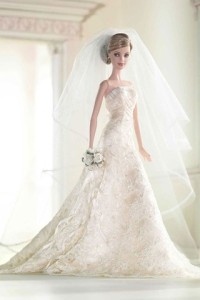 Carolina’s approach to wedding fashions is similar to her overall designs philosophy.
Carolina’s approach to wedding fashions is similar to her overall designs philosophy.
“I like simplicity–clean lines, touches of embroidery or lace. Not a lot of details. Definitely not ruffles and flowers everywhere. I try to be sophisticated and elegant at the same time. I like a bride with a long train and long tulle veil, with a blusher … the tradition of it is so pretty,” she says.
HERRERA IS ACTUALLY COUNTED AS ONE OF THE 7 MOST INFLUENTIAL BRIDAL GOWN DESIGNERS
“Fashion in the past meant that you had to have the guts to wear something different from others – to express your individual personality – but within the constraints set by formal standards of elegance and style,” she mused in the National Reviewinterview. “Today, people want to be free to wear what they like, in any combination they like, to be confined by no rules, and to set their own standards – yet they all end up looking exactly the same.”
“I have an eye for proportion, which is always the key to looking great, for mixing fabrics, and for shape, don’t ask me to cut or sew. I can’t do that. But I know exactly how a shoulder should lie.”
“The more you listen the more confused you get. You can’t design to please the press and to be in fashion.”
“The moment I leave my office I draw a curtain on my work, because you know what is really boring? When you work and work and then work some more, and you don’t realize it, but work is all you talk about all the time. Many designers have that problem. Work should be an important part of your life. But for it to be your life? That is very sad.”
(Carolina Herrera)
Filed under: Curiosity
In this day and age, a celebrity-wedding gown gathers much attention. With all of the high profile weddings for the stars, one can expect to see some very expensive and well-made dresses to cater to just about any taste. Some of the stars go with one of kind gowns, which will represent their own style and individuality. Many of the stars however, feel that the traditional gown is still the way to go. This is not to say that this traditional gown will be a run of the mill dress, as we all know the celebrities have money to throw at a wonderful gown…
Monique Lhuillier, the designer of celebrity wedding gowns
Move over Vera Wang, there’s a new designer-to-the-stars. Of course Vera Wang is here to stay, but the hot name on everyone’s lips right now is Monique Lhuillier.
Who is Monique Lhuillier?
Born to French, Spanish and Filipino parents, Monique Lhuillier was raised in the Philippines. The combination of her mother’s glamorous style and the extensive traveling of her family had a great impact on Monique and led to her dream of being a fashion designer. She attended the Fashion Institute of Design and Merchandising and upon graduation, took a job at a small French firm. But it was the process of designing her own wedding to future company co-founder Tom Bugabee that cemented her vision of her future firm. In 1996, she launched her first bridal collection.
What celebrities have worn Monique Lhuillier wedding dresses?
The designer’s dresses are often seen on the red carpet and in editorial spreads in magazines. But Monique Lhuillier wedding dresses have also been seen on more than a few high profile stars. Singer Pink wore an ivory and black Monique Lhuillier gown in order to make “Corey’s heart stop for a second.” Emilie de Ravin of TV’s Lostwore a lacey long gown at her intimate wedding, and Evestar Ali Landry also donned Lhuillier at her top-secret Mexican wedding to director Alejandro Monteverde. She really made a name for herself when she designed two high-profile weddings in a row. Monique Lhuiller designed Christine Baumgartner’s wedding dress for her fall 2004 wedding to Kevin Costner shortly after designing both of Britney Spears’s wedding dresses in her wedding to Kevin Federline. Not only did she make Britney’s long Italian Silk wedding dress, but Britney also chose this designer for the five burgundy silk crepe bridesmaids dresses, her extra-short lace dress post-ceremony, and her mother-of-the-bride and mother-of-the-groom dresses.
But Lhuillier has long been a designer to the stars, and has designed wedding dresses for Natalie Imbruglia, Charlotte Ross, Debbie Matenopoulos, and was chosen by over 300,000 viewers of the Today Show for Nikki Hensley’s wedding dress as part of their “Today Throws a Destination Wedding 2004” series. She also designed 2004 Emmy gowns for winner Allison Janney, and attendees Jamie-Lynn DiScala, Megan Mullally and Famke Janssen.
What is a Monique Lhuillier wedding dress like?
Her designs are very feminine, and marked by exquisite workmanship and luxurious fabrics. Very few have sleeves, and most are a-line with full dramatic skirts. Her dresses have a modern and stylish feel, while retaining a traditional romantic sentimentality.
How much does a Moniquie Lhuillier wedding dress cost?
The high quality of her gowns is reflected in her price tags. The bridal line typically runs from $2,000 to $10,000.
The 10 most expensive gowns of stars…
10. Mariah Carey
Gown: Vera Wang = $25,000
Shoes: Vanessa Noel = $1,000
9. Dayanara Torres
Gown: Reem Acra = $30,000
8. Christina Aguilera
Gown: Christian Lacroix = $30,000
Jewelry: Diamond Rosary = $10,000
7.Tori Spelling
Gown: Badgley Mischka = $50,000
6. Keely Shaye Smith
Gown: Two Richard Taylor designs = $60,000
5. Ashley Judd
Gown: Armani = $70,000
4. Madonna
Gown: Stella McCartney = $80,000
3. Melania Knauss
Gown: Christian Dior = $125,000
2. Victoria Adams
Gown: Vera Wang = $100,000
Jewelry: $160,000
1. Catherine Zeta-Jones
Gown: Christian Lacroix = $140,000
Jewelry: Fred Leighton = $300,000
BUT… WHICH IS THE MOST EXPENSIVE BRIDAL GOWNS IN THE WORLD…?
It has been created by an italian, Mauro Adami, and was exhibited as part of Hatton Garden Jewellery Week, one of the most big exhibition of jewerly in the world, that is located in London. The exhibition that takes place every year in London is the most famous of the sector, even because is the zone with the most high density of jewerly in Europe, 800 just in one district!
If you have 240.000 you can buy it at his showroom, in Milan.
Caracteristics of the dress are few but fundamental: important is the realization with 40 metres of silk and wire of platin!
Filed under: Interviews
Rosa has been a taylor for most of her life and I discovered that years ago she sewed the bridal gown for her niece, so I thought it would be nice to ask her something about the work!
There’s the interview:
- How was born the idea?
- Actually, it seemed stupid to us going to buy some expensive bridal gown when there was a taylor in the family! The model was suggested by a friend of mine, a modeller that had her shop in Piazza Carroccio and saw that fanciful dress on a magazine… We suddenly loved the idea and so the work started!
- What about the material you used?
- We bought everything from “Lorenzo Tessuti”, that was my trusted suppliers. My niece came with me to “touch” what would be made of her future dress.
- How much time do you need to complete the dress?
- More or less I employed two months
- There was an interaction between you and the model?
- Continuosly! You know, when you are sewing a dress tailor you always want the model to try it, to see if it does fit well.
- It was the first time that you tried your’s hand at creating a bridal gown?
- Oh no! I did eleven bridal gowns at all, before and after my niece’s (I have a lot of relatives!) and everytime for free, so I can’t tell you a price range for them… I did one even for my sister!
- Did you do all the work alone?
- Absolutely! I am a little bit jealous of my professional secrets.
- Were you satisfied of the result?
- Of course… It was a wonderful dress, exactly how we wanted it to be!
Here there are three of the eleven dresses Rosa sewed:
Filed under: Interviews
“Colomba più” is a big shop of bridal gowns, located in Villa Cortese.
The owners (Teresina Colombo and her daughter Fiorella Dell’Acqua) were so kind to give me an appointment and let me interview them.
- When was “Colomba più” born?
- First of all it must be specified that “Colomba più” is something different from “Colomba”. The first one is just the shop, where we sell our productions (coming from “Colomba”, the factory) and also creations of other stylist, even not italian. “Colomba” saw the light in 1971, when Teresina (who already worked as modeller for a tailor that made bridal gowns) decided that was time to go for her own way. We sold our creations here in the factory, like craftsmen (in effect we are craftsmen), then in 1989 we opened “Colomba più”, just on the other side of the street… It seemed the most logical consequence.
- Let’s talk about the production… Is everything “Made in Italy”?
- Regarding our production from “Colomba” absolutely yes, except for the laces that are French. We follow the entire process of creation in this building, also because we are a little bit jealous of our secrets. But, as I told you before, in “Colomba più” we sell also imported clothes, to make everyone satisfied… Of course, they have not the quality of the “Made in Italy”, but you can spend something less.
- What about your customers?
- We are very internationalized, we serve customers all over the world!
- In 1985 Fiorella created her own line of clothes…
- Yes, Fio’ Couture. I attend all the steps of the productions of my clothes: I design them, I choose the materials, I say my opinion about the advertising campaign… Everything! For us is important to be present even during the sell, we always try to welcome every customer!
- The last question: do you feel the crisis?
- Of course we feel! In this slice of market it’s even more strong because of new competitors that continue to enter in the sector of the bridal gowns! When “Colomba” was founded we were more or less 10 in all the Lombardy, now we are 50 just around Milan! We reacted trying to reduce the prices and investing in marketing, but you have always to consider that there lot of costs to cover and it’s not easy.
Filed under: Suggestions
Bridal Fashion Week is the chance for top designers to show off their new lines, and the chance to find out what’s hot in wedding fashion. Our current wedding fashion trends feel really diverse – you can have a wedding gown style based on pretty much any era of fashion and still be extremely fashionable. Here are 14 wedding dress trends for the spring 2010.
1. Sexy Slinky Silhouettes
If you’ve got a fab figure (or fantastic suction underwear!), now is the time to do a victory dance – sexy, figure-hugging wedding dress silhouettes will be hot for the next couple of seasons.
2. Ballgown Styles
For those who loved the wildly ridiculous yet fabulous gowns in “Gone with the Wind”, and for many of us who want to disguise our thighs, ballgown style wedding gowns are back. Fabulous! Ballgown wedding dresses have many rather wonderful upsides, including squishing you into the shape you desire, giving you fabulous cleavage, and being impossible to remove on your own.
3. Fifties style wedding gowns
…Is there something to say? 50s are back!
4. Mermaid Style Wedding Gowns
Apparently mermaid style wedding gowns are also a fifties influence, and thinking about it, one of the most famous dresses of all time is the dress Audrey Hepburn wore to the races in “My Fair Lady”, an extremely tight-fitting mermaid style gown.
5. Tea-length Wedding Dresses
Tea-length wedding dresses are fabulous for a more casual, less traditional wedding, especially if you have a nice pair of pins and some knock-out shoes. Once again, the 50s influence is shining through!
6. Grecian Goddess wedding dresses
Are you in touch with your inner goddess? Grecian style wedding dresses are hot at the moment – high-waisted with floaty materials. If you’re slim and small breasted, it’s a style that could look stunning.
7. Tulle
Tulle can be tricky to get right– you want to look ethereal without feeling like a little girl in a party dress. Artful draping combined with stunning bead-work make tulle the perfect combination.
8. Black is Back
Bits of black make wedding dress details pop, from bows and sashes to bolder embellishments and patterns.
9. Asymettrical Necklines
The one-shoulder style is gaining popularity. But this season, over-the-top details are what really makes them stand out.
10. Bows
These knots are hot, from droopy satin bows to more structured ones! Bows give your dress a feminine look that’s not too girly.
11. Flower Power
We love the burst of springtime blooms, whether it’s cherry-blossom details or embroidered, eye-catching rosettes.
12. Illusion Necklines
Sheer straps are the perfect coverage if you want something subtle and sexy. Whether it’s bateau, V-neck, or even one-shoulder, this look is dreamy!
13. Metallic Prints
If black details are not your thing, consider this hot, new style glittering in gold and silver details.
14. Top it off
To finish the look, designers are adding a hat! Whether it’s something dainty and demure with a birdcage veil, or a large, droopy picture hat, this is one trend we take our hats off to!
It’s funny to go for buying some salad and see in front of you a catwalk!
This happened on April 18th , at the Mall “Le Betulle”, located in Solbiate Olona, a small center between Milan and Varese.
If you glance at the backstage you can see the girls dressed in white (and not only), and you suddenly understand it’s a bridal gowns’ parade!
The stylist is Michela Elite.
Michela Elite S.r.l. was born in january 1990, in Scafati (Sa), from the great sartorial experience of the stylist Michela Merolla.
The models they realize are classic and made with refined tissues. Organza, satin, silk and macramé are selectioned from French suppliers, to satisfy a clientele that pay more and more attention to quality and particulars. The production is exhaustively “MADE IN ITALY”, they own a showroom in via Montenapoleone and have partners also in USA, Russia and Japan.
Luckily I can reach the backstage after the show and I have the possibility to speak just for few minutes with the organizer of the event, Maria Gabriella.
She is the owner of “Matrimonio Sposa”, a company specialized in wedding planning.
- “Why did you choose to have a parade in a mall?”
- “We were looking for something particular, innovative… Did you expected to find a catwalk just right here? Our target was to surprise everyone”
- “What about the stylist just performed?”
- “She is Michela Elite, she produces fashion bridal clothes, exclusively “MADE IN ITALY” and have a showroom in Montenapoleone. She’s quite famous, sometimes also appears on “Vogue”!”
- “Does she serve only the Italinan market?”
- “Oh no, she is very internationalized! She has customers also in Asia!”
- “Do you think is this sector having some difficult with the great actual crisis?”
- “Oh no! I think that real professionals remain the same also in difficulty. We are talking about a luxury part of the market… People are not ready to renounce to the quality of the dress they will wear in the most important day of their life. Now I really have to go, we are late!”
Filed under: The industry of bridal gowns
David’s Bridal outfits one-third of America’s brides — on the cheap…
History
The original David’s Bridal started in the 1950s with a single location in Fort Lauderdale, FL under the founder and original owner David Reisberg.
In the early seventies Phil Youtie purchased the store and decided to keep the established name. Like most bridal stores at the time, the original David’s Bridal stocked only sample gowns in a standard size. Youtie had changed the store model in the late 1980’s with a warehouse style store off I95 where they sold designer gowns, discontinued dress and manufacturer over runs at below retail prices. The “David’s Bridal Warehouse” did not have dressing rooms and had a concrete floor. This was based after many wholesale warehouses at the time and served them well until other local bridal store complained to the designers for allowing this. Within a couple of years and many local stores going out of business, the designers that supplied gowns to the David’s bridal stopped. David’s Bridal has since changed the model to more traditional stores with a selection of their own designed wedding gowns, in stock, in most common and some plus sizes. Most stores can now provide on-site alterations, financing options, and gown preservation services.
Business Practices
David’s Bridal stores have an all-sales-are-final-policy. Even if a customer does not wear a dress, and does not have it altered in any way, their policy is to not refund money under any conditions; having a receipt doesn’t make a difference. Online purchases are returnable; however, a large number of items are found in the “sale” and “outlet” sections; these are unreturnable.
With more than 300 stores throughout the country and a growing online presence, the retailer offers unbeatable prices on a wide selection of mass-produced gowns.
While the average wedding gown costs $1,075, according to Condé Nast Bridal Media, the average David’s Bridal dress retails at only $550. Some sell for just $99. It has been called the “Wal-Mart of weddings,” and, like the blue big-box giant, David’s Bridal may be poised to emerge from the recession as an even more formidable retail force.
Many small independent dress shops have shuttered recently due to the economic downturn. Meanwhile, David’s Bridal is in the midst of what it calls “an ambitious expansion program.” The company is sitting pretty compared with the rest of specialty retail.
David’s Bridal is privately held, so while it doesn’t publish revenue figures, Thomson Reuters estimates that its sales were $683 million in 2008.
David’s Bridal has added about 15 to 30 stores annually since 1999. Even in the past year’s gloomy retail environment, it opened 20 stores. The brand’s budget-friendly reputation appears to be paying off.
The newly opened store has a utilitarian feel: racks and racks packed with plastic-wrapped gowns, organized systematically by price and size (2 through 26). There are no champagne toasts or doting bridal consultants. Most of the bustling brides pick through the dresses like they’re shopping for groceries.
Customers don’t expect to find high-end silk gowns at David’s Bridal. And brides have never gone there because it’s a fancy place.
“The first store didn’t even have carpet on the floor,” says Phil Youtie. Most bridal shops only stocked dresses in sample sizes, so customers would have to wait months for their own dresses to be manufactured, delivered, and altered.
David’s Bridal not only offered on-the-spot purchases but also bargain-basement prices.
Lots of people in the wedding industry loathe David’s Bridal. That’s because, for years, bride after bride has jilted her local boutique and purchased a dress from the chain instead.
“Whenever a David’s opens up, business drops instantly,” says Sally Conant, executive director of the Association of Wedding Gown Specialists. Most small shops can’t afford to stock dresses in every size or discount their merchandise as deeply as David’s Bridal does. Because its dresses are typically made with cheap materials, manufactured abroad, and purchased in bulk, they’re some of the least costly gowns available. As a result, David’s Bridal claims an estimated 50 percent of the $600-and-under wedding dress market.
The current economic downturn could be the perfect storm that David’s Bridal needs to capture even more market share. While the recession hasn’t deterred couples from tying the knot, it has shrunken their budgets substantially. The average cost of getting married in the United States slipped in the first quarter to $19,212, according to the Wedding Report, a market research firm. That’s down from $21,814 last year and $26,450 in 2005.
Brides-to-be are opting for cupcakes instead of wedding cakes, downsizing their guest lists, and, yes, compromising on what may have been the dress of their girlhood dreams. According to a recent survey, 55 percent of brides plan to spend no more than $600 on their dresses.
That means that those who may not have set foot inside a discount shop like David’s Bridal in the past are venturing in.
The real test for David’s Bridal—and most budget-friendly retailers today—will come when the economy rebounds. Of course, therein lies the big difference between David’s Bridal and Wal-Mart: People shop at Wal-Mart regularly, whereas David’s Bridal is presumably seeing most of its customers for only one purchase (or not much more than one).



